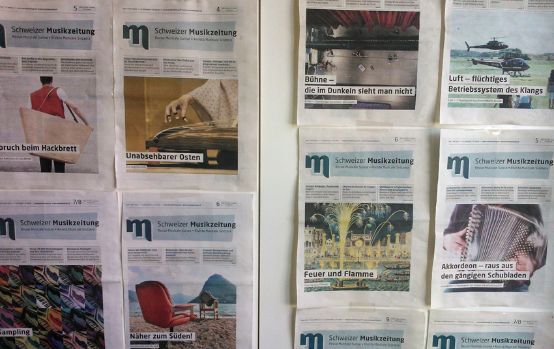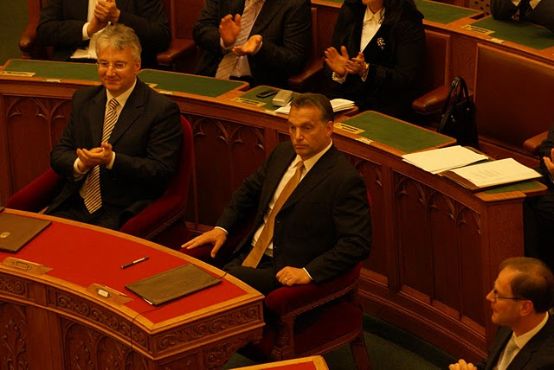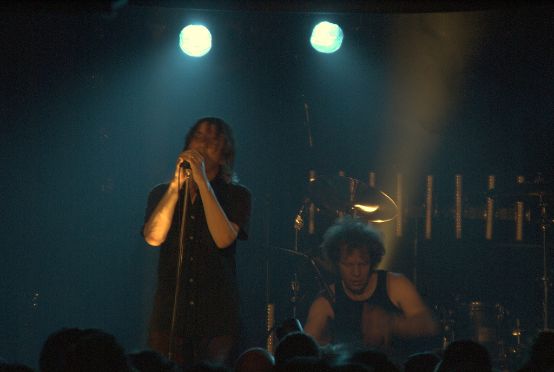The articles on the crisis at the Schweizer Musikzeitung in the October issue prompted many readers to comment. We are publishing the letters and messages here in chronological order.
You will find the letters in French here.
November 28
The delegates of the Schweizer Musikzeitung association are handing over the publication of the Schweizer Musikzeitung to NZZ Fachmedien AG as of January 1, 2015. Further details can be found here.
As a hobby cellist and newly retired, I certainly don't represent the majority of the readership.
I will probably receive the SMZ as a member of SMG.
It has improved my understanding of the processes and interrelationships of the cultural sector. I believe that if this information is no longer disseminated in paper form, cultural professionals will lose a great deal. In my generation in particular, there are many people who know how to use IT, sometimes only minimally, but who would never think of looking for this information online. You would gradually lose all these sympathizers and their appeal to younger generations. The result would be declining interest in the music and in the problems and opportunities, declining knowledge of events and thus fewer visitors, until only a core remains that can't carry the whole operation on its own and becomes increasingly elitist. - Then it's almost too late.
I simply cannot imagine that subscribers are not prepared to pay a little more for this magazine in its current form.
Ueli Heiniger, St.Gallen
November 27
As a Swiss composer who has been living abroad for 30 years, I would like to hope that the various music associations will make up their minds to support the only specialist magazine in the country financially in order to guarantee it a reasonable basis. For us musicians living abroad, your esteemed newspaper is often the only informative contact with the Swiss music scene.
Thomas Fortmann, Arcidosso (I)
October 28
Editorial office. Following a meeting of the Board of Directors with some of the presidents of the member associations, plans are taking shape to ensure that the Schweizer Musikzeitung can continue to be published in print. However, some things are still up in the air. The Extraordinary Assembly of Delegates will make the final decision on November 28.

- Photo: SMZ
October 27
The SMZ is a key source of information for musicians, especially in print form, which complements Dissonance perfectly.
Reducing the SMZ to an exclusively online format does not do justice to musicians' interests and limits the number of people reached by the SMZ in a highly unfortunate way, as the print version is available in music schools and colleges and invites people to browse through it. For the online version, you would have to consciously go to the website, and many people who simply read the newspaper will not do that. This drastically limits the distribution of SMZ content and makes it less interesting for advertisers.
That's why I advocate the continuation of the print version.
Burkhard Kinzler, Professor at the ZHdK
It would be a great pity if the Swiss music magazine were to disappear from the scene!
Why shouldn't the music magazine cost something?
I would prefer that to an online edition, which I would probably not read.
Aline Du Pasquier, Basel
October 22
Web is perhaps half the voice
Social media. The paperless office. Intranet. Blog. But do you also know spam? Or shitstorms? The paperless office is impossible. 90 percent of emails are annoying spam. An increasing proportion online is shitstorm, escalation, outrage. We are on the electronic needle, and the daily dose of computers is already calling for alternatives in many places.
If you type "Schweizer Musikzeitung" into the search engine, you get around 27,600 results. If you type in "music publisher", you get around 406,000. For me, this means that real information is increasingly losing its value on the web. Digitalization will probably make us more clueless in the future than we are today. Perhaps in 20 or 30 years we will return to the stage that prevailed until the rise of newspapers in the 17th century: that of public ignorance. Is that what we want? Is that what the Swiss music associations really want? The musicians? The publishers? The researchers? The music schools?
In today's world, both online and print are needed - each with its own strengths. A web-only solution leads to the virtual afterlife.
Erich Herger, Altdorf, editor of the Mülirad publishing house, lecturer at the University of Fribourg, Department of Communication Science and Media Research
I was introduced to the SMZ about five years ago by the two music journalists Sibylle Ehrismann and Dr. Verena Naegele. Since then, I have read every issue again and again with curious interest, great respect for the quality of the background articles and great admiration - not to say envy - for the diversity of their commitment to musical life in Switzerland. Chapeau!
The print edition is always an informative companion, especially on long train journeys. In many archives and libraries at home and abroad, I find it almost like a piece of home. And this of all things is to be abandoned in a coup? What level of whining is going on here and why? All the figures say the opposite, any renowned publisher would envy you!
Giving up the print edition would be like tearing down the foundations of a house or only listening to canned music. Of course, the media sector can no longer do without "online", the business areas have to be expanded and are sometimes oriented in very different directions, but the haptic products are still there, the print editions as "brands" are strategically essential for survival. Just think of the German weekly newspaper DIE ZEIT, which is expanding into other sectors and has a diversified offering ranging from cultural travel to academies, from art to school campuses. Regular events were also held in Switzerland, such as "RedeZEIT" at the Theater Basel with distinguished guests such as Micheline Calmy-Rey, Josef Ackermann and Carla del Ponte. BUT: without the DIE ZEIT brand behind it, such events would not have the slightest chance on the market. SMZ should therefore not give up this basis, its history and its brand lightly.
The reception of online editions is also completely different to that of print media, as we have long known, and the content has been adapted accordingly: it may be good for quick information, but in-depth background articles are hardly ever read in depth or to the end online, which is probably why they are hardly ever published online at all. This is precisely what we should be more concerned about, namely that valuable content is being lost along with the print edition. Not to mention the jobs that depend on it ...
Dr. Gudrun Föttinger, Deputy Director of the Richard Wagner Museum in Bayreuth (D)
October 21
For me as a music journalist, the Schweizer Musikzeitung is the central source of information about Swiss musical life. It is well edited, clearly laid out and covers interesting topics. It is clear that an online edition is needed alongside the print medium these days. But if you dive completely into the Internet, you will get lost in the jungle of information. I am often abroad for research, in large music archives and libraries. I always see the Schweizer Musikzeitung (Swiss Music Newspaper) there, it's an unmissable presence and with it the Swiss music scene. It is difficult to understand how the major Swiss music associations, which have come together to produce this informative joint newspaper, can underestimate the representational value of this print medium to such an extent.
Sibylle Ehrismann, Rombach
I am contacting you in the hope that a solution can be found to keep the Schweizer Musikzeitung alive. The cultural heritage of a country is infinitely difficult to bring back to life, but it can be deleted at any time. With best regards and admiration for the quality of this music magazine.
Violeta Dinescu, University of Oldenburg, Faculty III, Institute for Music
I am very sad that things are so bad for the SMZ. The fact that the associations have so far been unable to come together to save the common platform they have in the SMZ is - to put it mildly - very sad and reprehensible in itself; especially as the musician clientele should be particularly sensitive, as they are barely able to survive in the cultural sector without subsidies. And the few francs that the SMZ costs would not be worth mentioning. But I'm willing to bet that the associations will moan when they realize this (too late) and have to set up a new platform where the music industry can find each other.
Christoph Greuter, Solothurn
October 20
I am a basic music teacher in Reinach BL and the only newspaper (sometimes the BAZ) I have in my letterbox is the Musikzeitung. I am shocked that in this day and age something valuable has to go to waste once again.
I would hardly read the newspaper online every month, only when I have no other option. But knowing myself as well as I do, it wouldn't be once a month.
Your valuable contributions, advertisements, pure cultural tips - where can I find that in a magazine?
I sincerely hope you can find a solution to ensure that the newspaper continues to find its way into my letterbox!!!!
6% is feasible, isn't it?
A coffee may cost 3.80 in the country - in the city you can get a coffee for 4 to 5 francs, not cheaper!!!
Maria Rusterholz, Basel
I would find it very regrettable if the SMZ were to be discontinued in paper form because of a comparatively small deficit. The whole family always reads the articles with great interest. We can hardly imagine reading the newspaper online. Switzerland needs a music magazine and I think the range of editorial articles could be expanded!
Thilo Muster, Basel
that would be an extreme pity if the music paper were to go under, especially since the deficit doesn't seem to be endless (6%?)
Dorothee Labusch, Winterthur
October 17
This is of course bad news - although unfortunately not entirely surprising. The fact that, according to the chart on page 5 of the last issue of SMZ, there are almost twenty times as many association subscriptions as "normal" subscriptions is difficult to understand in view of the decline in advertising income. It used to be said that the associations involved in the Musikzeitung generated the advertisements. If this no longer works to the same extent today, the associations must therefore provide the missing funds elsewhere.
What is not clear from the chart is the website's share of costs and revenue. My guess is that the website brings in much less than planned during the restructuring. If that were the case, it would make no sense to discontinue the newspaper and concentrate on the Internet. Rather, we would then have to consider whether the costs for the website (which I actually like!) should not be radically reduced.
Werner Joos, Schaffhausen
October 15
It is with great sadness that I hear of the plans to discontinue the print edition of the Schweizer Musikzeitung and replace it with an online edition. I have been a reader of your magazine for many years and would very much regret this for several reasons:
1) The newspaper provides a wide range of information about Swiss pedagogical musical life and is therefore for me an important key to musical life in Switzerland and to the pedagogical trends in your country, to the Swiss voice in the "concert" of international music education.
2) The educational articles, the reports from the regions and the reviews are very interesting and important for publishers.
3) There is sufficient evidence in the industry and (music) business that you can still reach customers very well via a print edition. Print and online information should never be played off against each other - both complement each other. It's not a question of pros or cons. With the ever-increasing flood of newsletters and advertising mailings, there is a danger on the Internet that the content will get lost in the flood of information and be less noticed than before. I certainly wouldn't wish that on Swiss music teachers and their magazine.
Everyone naturally understands that in difficult economic times, costs and revenues need to be examined and brought into a healthy balance. That is undisputed. But surely there are other ways of doing this than giving up such an important magazine? Creative and constructive solutions should be sought!
We see everywhere that countries, cities and municipalities are cutting back on culture. All too often, unfortunately, music comes first. But when a music association itself resorts to such a measure, this is doubly questionable: doesn't an educational association need a mouthpiece and a medium for internal communication?
Dr. Rainer Mohrs, Chief Editor Schott Music, Mainz (D)
The news about the imminent "end" of SMZ hit like a bombshell - especially as the broad range of institutional associations in the responsible sponsoring organization represents the music landscape of an entire country. I asked myself: How can a magazine like this get into difficulties? The answer came with the October issue and the disclosure of the finances. And it turned out that the figures are actually phenomenal: the fact that the SMZ finances almost 80% of its budget from advertisements is fantastic - every other magazine will envy it. The reason for this unique quota is probably the relatively high circulation and the wide reach of SMZ, which also extends beyond national borders. But when I read that the associations in the sponsoring association apparently pay just CHF 1.50 (!) for each annual subscription, yet these same associations are surprised at the financial deficit, it simply leaves me speechless. Because this 1.50 is far below the actual production costs, and it is a sum that people will willingly put into a parking meter at any time. It doesn't take much arithmetic to realize that there is simply something wrong with the structure here.
However, if the associations now simply abolish the SMZ, they will deprive themselves of their biggest mouthpiece at a difficult time for culture in the broadest sense. Instead of speaking together and with one loud voice, everyone is apparently supposed to fight for themselves from now on. The fact that this is openly playing into the hands of other interest groups seems to go unnoticed. In a lively game of "everyone against everyone", everyone will lose. If it weren't so sad, one could also speak of suicidal behavior. And anyone who thinks that the Internet is the only future is very much mistaken and is succumbing to a misconception that is still being propagated all too blithely. On the Internet, people are actually looking for information - and advertising revenue is determined by the number of clicks. A newspaper as varied as the SMZ, however, invites you to pick it up several times and to inform yourself from a different angle. A newspaper lies on the table and imposes itself...
What is still being squandered, however, is the unique concept of the SMZ from a European perspective: not only are different associations under one roof here, but different languages are also on an equal footing. There is hardly a better way to make your voice heard in Switzerland when it comes to music.
Correct action is therefore urgently required now. If the SMZ does not appear in print in January 2015, it will not do so in the future either. Moving to the Internet will only delay the dying process. And who is going to get it all up and running at short notice and for less money when the editorial team has already been laid off? The fact that the associations are so recklessly and so radically gambling away their most effective flagship over a few centimes is simply shocking and shows (as can also be seen from the latest editorial) that the real consequences have not been considered by the decision-makers, apparently driven by their own insecurity.
Dr. Michael Kube, research associate at the New Schubert Edition and lecturer at the Stuttgart University of Music, Angelbachtal (Germany)
We greatly appreciate the music reviews in the Schweizer Musikzeitung. They are knowledgeable, critical and independent. There are not many newspapers that offer their readers this indispensable service at this level. Thank you for this and keep up the good work!
Olav Roßbach, G. Henle Verlag, Munich (D)
The sparrows are whistling it from the rooftops and we are horrified: The music magazine is to cease publication? This horror scenario will hopefully be averted. So far, all print magazines have failed in the online sector and the Musikzeitung will probably be no different.
We would like to express our unconditional support for rescue plans of any kind for the printed edition.
Sabine Kemna, Pan Verlag GmbH, Basel/Kassel
October 14
The bad news startled me. Even as a student, I benefited a lot from reading the Musikpädagogische Blätter in the 1960s, have been writing articles and reviews since the 1970s and thought it was wonderful when the newspaper opened up from the SMPV to all music associations and, for example, every amateur orchestra player found the paper in their letterbox 11 times a year as a matter of course. I was positively astonished to see that even the Swiss Choral Association, which had held on to its own publication for years, had now joined in. Even if not everyone pays the same attention to the magazine, those who delve into at least two articles benefit from it. If it only appeared on the Internet, it would no longer lie on the bedside table, coffee table or in the quiet little room and be picked up!
It would be enough to win over one or two music-loving millionaires for a foundation that would be a piece of cake for them, and the SMZ could live on.
Unfortunately, I don't know any millionaires, but perhaps this is helpful food for thought.
Walter Amadeus Ammann, music teacher SMPV, Berne
It is clear that I will send my SMV contributions directly to the SMZ in future if the association does not support the paper SMZ considerably better.
Michael Murray-Robertson, Lussery-Villars
October 13
We see the Schweizer Musikzeitung as the most important mouthpiece for all music news in Switzerland, comparable to the Neue Musikzeitung in Germany. For us, it is the source of information for news from Switzerland and, conversely, the most important place to publicize our Breitkopf editions and Breitkopf novelties in Switzerland. We are enthusiastic about the high journalistic quality, especially the music and book reviews, which should be emphasized more strongly again. All this must be preserved at all costs in order to guarantee diversity of opinion and protect music as a cultural asset.
Melisande Bernsee and Dr. Frank Reinisch, Breitkopf & Härtel KG, Wiesbaden (D)
October 12
It is with a sad eye that we hear about the difficulties of the "Schweizer Musikzeitung".
Let me express my regrets in this mail. We all know about the difficulties of printed editions. But I am sure that you will find a way to lead this traditional newspaper into the future.
Gerhard Halbig, Musikverlag Holzschuh, Manching (D)
It was with great dismay that I read the news that SMZ's physical existence is to end at the end of the year and that it will only be present virtually, if at all. I was blindsided. And a little annoyed, because shouldn't we readers, who want this SMZ, have been informed much earlier about the state of the SMZ? then we could have decided whether it was worth spending those 3 francs per issue. As it was, we were simply presented with a fait accompli and there was nothing more we could do. I would have spent those 3 or even more francs without a moment's hesitation, because for me the SMZ is an important part of my job, where I can find information and also read up on topics that are not so obvious to me. I always enjoyed reading their newspaper during my long train journeys to pass the time. I find it really very good, informative, entertaining and stimulating. Many of my colleagues feel the same way. After reading your newspaper, I was completely up to date again. And it's just not the same to have to stare at the computer in the evening after a busy day and have to fight your way through so much information. Not to mention those of us who are not yet so well versed in this new virtual world.
I have heard that there may now be a possibility of continuing the SMZ in physical form after all. I would be very happy about that and can only support these efforts. And otherwise why don't you ask us readers? Perhaps others will be prepared to pay for a subscription. After all, quality has its price!
Annette Dannecker, Zollikon
October 10
We have just received the surprisingly bad news that the Schweizer Musikzeitung is to be discontinued or reduced to an online format. I am writing as an employee of the music publisher Doblinger Wien. Not only do we regularly read the Musikzeitung in order to obtain interesting information about Swiss musical life, but we also send our new sheet music publications for review. It is the only advertising opportunity for us in Switzerland, and we are pleased that reviews of our editions appear time and again.
It would therefore be a great loss if this only music magazine in your country were to disappear from the scene. We have only had bad experiences with online solutions so far - some magazines that have switched to online have been discontinued shortly afterwards, others lead a shadowy existence and are therefore no longer relevant as an advertising medium.
Katharina Knessl, Musikverlag Doblinger, Vienna (A)
it was with regret that i read that our musicians' newspaper is on the brink of extinction. however, i am dismayed by the board members of the various associations. they have obviously not managed to consolidate the financial situation of the paper. as a former central board member of the smv, i unfortunately also had to witness the demise of our own musicians' newspaper. at the time, i thought that the musicians' newspaper would somehow continue. and now this!!!
i consider it extremely important to have my own newspaper, especially as i'm not one of those idiots who fondle their cell phones all day to keep up to date with current events. it should be possible to receive a cost-covering amount from the members of the associations and from the associations themselves for the maintenance of the musicians' newspaper - as shown, the value of a cup of coffee.
i am willing to pay a fiver to receive the magazine. i refuse an online version.
h.-p.schiltknecht, ammerzwil
We can't imagine the Swiss music scene without the Schweizer Musikzeitung! We appreciate the competent work of the editorial team and the variety of topics that can be found in the SMZ.
Here at Bärenreiter-Verlag in Germany, we obtain a large part of our information about musical life in Basel, Bern, Zurich, Geneva and the other centers and regions of Switzerland from this magazine. We cannot and would not want to do without it.
Kerstin Lehmann, on behalf of the press office and management of Bärenreiter-Verlag, Kassel (D)
Thoughts on the future of the Swiss music magazine
For me as a performing musician, the SMZ has become an indispensable journal since my student days, and the thought of discontinuing the publication worries me. Why?
-Is it conceivable that in a country as linguistically and culturally diverse, and in certain respects disparate, as Switzerland, there is no longer a national publication that provides an overview of the position situation, but also of concert life, music education, musical research and "trade union" activities in all parts of the country?
-Wouldn't it be particularly important in such a context that - in an age that is focusing more and more on mobility and flexibility - a publication like SMZ offers the opportunity to look for interesting offers, jobs and projects across language barriers?
-Is it conceivable that in the future it will no longer be possible to gain an insight into the activities of the various music academies and musicological institutes at all the universities in our country in a single publication?
-Is there any alternative to reaching such a large field of professional colleagues with a single publication when advertising courses, job advertisements and project work?
-Aren't the possibilities of networking with other musicians, their work and research becoming more and more important for musicians? Isn't it essential to have a publication that is as open as possible, which can shed light on different aspects with thematically changing focal points and invites you to set off on your own research if you are interested in a particular area? There are quite a few specific publications (church music, choral conducting, new music ...), but practically none that are "open".
-Or more generally: in an age whose credo is transdisciplinarity, interdisciplinary action, insight into other styles, even cross-over, does it make sense to deliberately forego an important source of information?
-Don't we musicians need a central platform for advertising interesting jobs in order to be able to search for suitable offers in line with the situation - including cross-comparison? Or will we have to rely on the depths of the internet in the future to hope for our luck when searching for job advertisements - hopefully clearly marked as such - on the homepages of all possible institutions?
-Is there not a need for a "neutral" publication - especially in the area of church musician positions - in addition to the denominationally bound journals, which summarizes all those offers that would otherwise have to be searched for in at least three different specialist journals?
-Isn't there also a need for a central overview of courses and further training that can also be compared, especially as these are offered in an almost inflationary manner today and you almost get lost in selective searches on the Internet etc.?
Tobias Willi, organist and professor at the ZHdK, Zurich
October 7
What I read in the latest issue of SMZ about the gloomy financial outlook for the future is worrying. But what will happen to subscribers if the print edition disappears? Will this content then simply be available as a PDF with a subscription number and name (as is already possible)? In that case, I would certainly no longer consider renewing my subscription. And I don't think I would be an "inventor - the joy of searching" in this respect.
https://musikzeitung.ch/wp-content/uploads/smz_content/fr.jpg
smz
04.09.2014
Adolphe Sax was born two hundred years ago. An occasion to take a closer look at the process of inventing new instruments.
Adolphe Sax was born two hundred years ago. An occasion to take a closer look at the process of inventing new instruments.
Focus
A Daniel Gyro Gearloose of the 19th century
Adolphe Sax and his adventurous life as an inventor
Les sons éthérés du thérémine
Cet instrument répondait à la volonté de son inventor de " contrôler les sons et leurs nuances par le libre déplacement des mains dans l'espace "
German summary and video examples
Flash of inspiration or work of patience?
Instrument makers, sound artists and hobby tinkerers provide answers
Video examples
" L'art est vecteur d'innovation "
Alain Crevoisier opens his atelier to us and tells us about his journey
Video: Alain Crevoisier plays on the Airplane
... and also
RESONANCE
Slow, quiet and beautiful: Andreas Zurbriggen in conversation
The FIMS in Fribourg: A stroke of luck for Swiss festival culture
Jacques Tchamkerten : au service d'une curieuse invention
Bells, ghosts, glass harmonica: Swiss-French-Festival in Berlin
Reviews Classical, Local & Global - New releases
Carte Blanche with Michael Kube
SERVICE
" I ha nüt " : un festival suisse alémanique à Cully
FINAL
Riddle : Dirk Wieschollek is looking for




























